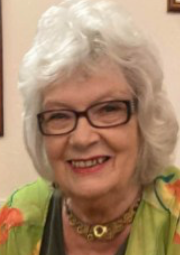Murder by
Christmas
The
twisting twenty-fifth instalment of Lesley Cookman's much-loved Libby Sarjeant
series
Libby Sarjeant is deep into rehearsals for the annual pantomime when a body is
found in a doorway two weeks before Christmas - and Libby and her friend Fran
are called into action once again, when their investigation leads them to a
local brewery and the sale of many of its pubs.
With the help of a team of local publicans, can Libby and Fran unravel the case
before it's too late?
Purchase Link - https://mybook.to/wWqwaY8
Author
Bio – Lesley
started writing almost as soon as she could read, and filled many Woolworth's
exercise books with pony stories until she was old enough to go out with boys.
Since she's been grown up, following a varied career as a model, air stewardess
and disc jockey, she's written short fiction and features for a variety of
magazines, achieved an MA in Creative Writing from the University of Wales,
taught writing for both Kent Adult Education and the WEA and edited the first
Sexy Shorts collection of short stories, in aid of the Breast Cancer Campaign.
Lesley is a member of the Society of Authors and the Crime Writers'
Association.
Lesley has also written pantomimes performed all over
Britain, and published a
book on how to do it!
Learn more about Lesley by visiting
her blog.
Social Media Links – https://www.facebook.com/LibbySarjeantMysteries/
https://twitter.com/CookmanCrime
https://www.instagram.com/lesleyrcookman/tagged/
I'm delighted to invite Lesley Cookman to share her views on how to write a good murder mystery.
How To Plan A
Murder
When I was a
child, my parents let me loose on their bookshelves and I devoured all their
Golden Age Mystery novels. There wasn’t much differentiation between genres in
those days, and they were just novels – and I loved them. So when I grew up –
which is debatable - I decided to write
them. When I thought about it in a vague way before I morphed into a crime
writer, I assumed you would start with the murder and work backwards. Now I
know it isn’t as simple as that.
There are no
rules for crime writing. If you write in a specific sub-genre: thriller,
medical, psychological, police procedural or cosy (like me) there are lines
over which you do not cross, but little is hard and fast. What are
incontrovertible facts are – if you are writing a “puzzle” story, remember to
insert unobtrusive clues from fairly early on. If the police are involved, get
the details of an official investigation right. Those are self evident, of
course, and everything else is exactly the same as any other novel – do your
research, don’t let the story get away from you, create good characters. Unless
it’s an integral part of the story don’t let an unfolding romance send your
protaganist (s) off the rails. Romantic suspense is different – but there, the
romance is an integral part of the
story – think Mary Stewart.
So, here are a
few wise words for the new crime writer. Don’t start with a dream or a
flashback (although I think I have...) and Don’t Start Bland! [sic]. Don’t
start the story too soon. Don’t forget that a mystery, or crime novel, is plot
driven but the plot is driven by the characters. Depending on what sub-genre
you have decided on, there should be at least one murder. The great Carter
Dickson got away without one occasionally, but lesser mortals should stick to
the rules. Make sure the murderer appears early in the story. If he, she or it
doesn’t appear until late on in the book, the reader is likely to feel cheated.
If the
detective/problem solver is to be the main protaganist, make sure they also
appear early and unless they are official, give them a definite reason for
getting involved. If they are a suspect in the main crime, the reason for
getting involved is obvious – they must clear their name – but otherwise, don’t
make them a suspect! However, introduce at least one suspect by the end of the
second chapter, and make sure there are several VIABLE suspects by the end of
the book. Not just people you’ve stuck in to make up the numbers.
The actual plot –
my original idea of starting with the murder and working backwards is actually
quite a good one, taken from the murderer’s point of view. A needs to kill B.
Set that up and watch A cover his/her tracks. Then, with a bit of luck and careful
concentration, you can go back and unpick it. This, of course, would be the
ideal method, and I’m sure if I did this every time my life would be easier.
The other wise
words are no different from those given to any writer, crime or otherwise, as
I’ve already said. And here are my final exhortations: DON’T DO WHAT I DO.
In the first
Libby Sarjeant I was told at the end that the murderer wouldn’t do, and could I
put in a new character. I did. With two
weeks to go.
We have got stuck
with the “Murder” titles. So whatever story I decide on has to have a suitable
title. And frequently I then have to fit the story round the title. This is NOT
a good idea.
Don’t have a
brilliant idea for a title with a bit of a story wafting round the edges, tell
your publisher and then get stuck with it. Most of my books are written out of
desperation.
Actually, of
course, a good murder mystery is both satisfying to read and to write. It can
be bent into all sorts of shapes by all sorts of people. After all – look at
me!




Thank you!
ReplyDelete